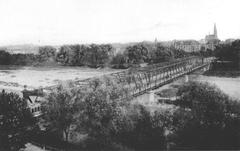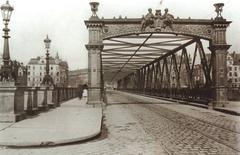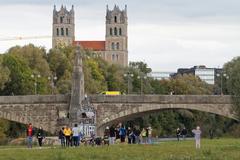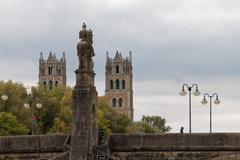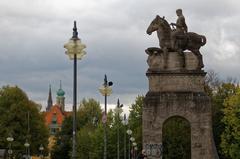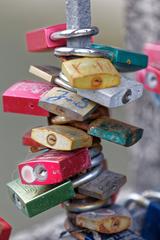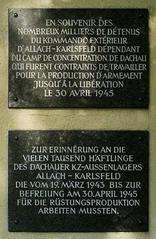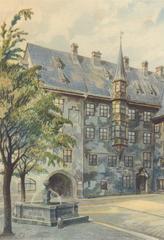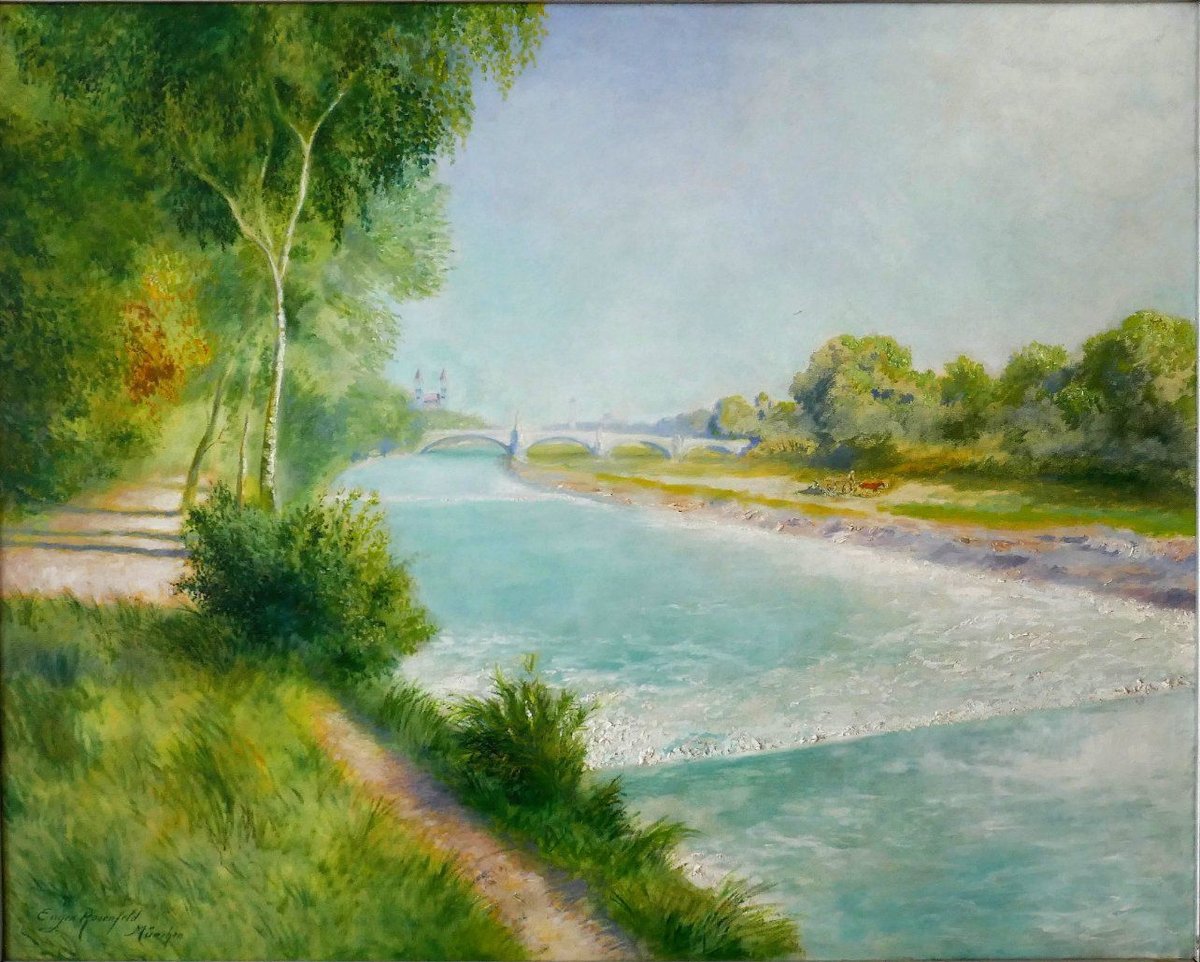
Comprehensive Guide to Visiting Wittelsbacherbrücke, Munich, Germany
Date: 18/08/2024
Introduction
The Wittelsbacherbrücke is not merely a conduit for crossing the Isar River in Munich, Germany; it is a historical monument that encapsulates the rich cultural and architectural heritage of the city. Named after the illustrious Wittelsbach dynasty, which ruled Bavaria for centuries, the bridge offers a unique blend of historical significance and modern-day relevance. Initially constructed in 1874 as a wooden structure, the bridge underwent substantial transformations, including a significant reconstruction in 1904 that replaced the original wooden bridge with a durable concrete and steel structure. This was part of a broader trend in early 20th-century Europe to modernize infrastructure. The bridge’s architectural beauty is accentuated by the equestrian statue of Duke Otto I, designed by Theodor Fischer, making it not just a functional structure but also a piece of public art (Muenchenwiki).
The Wittelsbacherbrücke serves as a vital link between the districts of Isarvorstadt and Au, playing various roles in the social fabric of Munich. It has been a popular spot for locals and tourists alike, offering picturesque views of the Isar River and the surrounding areas. The bridge’s inclusion in the logo for Munich’s hosting of the UEFA Euro 2021 exemplifies its enduring importance as a symbol of Munich’s heritage (Wikipedia). For those planning to visit Munich, the Wittelsbacherbrücke is an essential landmark that offers a glimpse into the city’s storied past and its ongoing cultural evolution.
Table of Contents
- Introduction
- History of Wittelsbacherbrücke
- Architectural and Artistic Contributions
- The Wittelsbach Dynasty’s Influence
- Visitor Information
- Activities
- Dining Options
- Safety Tips
- FAQ
- Conclusion and Call to Action
Wittelsbacherbrücke: A Historical Guide to Munich’s Iconic Bridge
History of Wittelsbacherbrücke
Origins and Early Construction
The Wittelsbacherbrücke, an iconic arched bridge in Munich, Germany, spans the river Isar and connects the districts of Isarvorstadt and Au. The bridge’s origins date back to 1874 when it was initially constructed as a wooden bridge. It was named after the Bavarian Wittelsbach dynasty, a ruling family that significantly influenced the region’s history and culture.
Rebuilding and Architectural Significance
In 1904, the wooden structure was replaced with a more durable construction of concrete and steel. This transformation was part of a broader trend in the early 20th century to modernize infrastructure with more resilient materials. The new bridge not only improved transportation but also became a symbol of architectural advancement in Munich.
The Equestrian Statue of Duke Otto I
One of the most notable features of the Wittelsbacherbrücke is the equestrian statue of Duke Otto I, which was added during the 1904 reconstruction. This statue was designed by Theodor Fischer, a prominent architect who also contributed to the design of other Munich bridges, such as the Prinzregentenbrücke. The statue and its intricate details reflect the artistic and cultural values of the period, making the bridge not just a functional structure but also a piece of public art.
Social and Cultural Impact
Over the years, the Wittelsbacherbrücke has played various roles in the social fabric of Munich. It has been a popular spot for locals and tourists alike, offering picturesque views of the Isar River and the surrounding areas. However, it has also been a refuge for the city’s homeless population. In November 2018, police cleared a homeless camp from underneath the bridge, highlighting ongoing social issues within the city.
Modern-Day Significance
The Wittelsbacherbrücke continues to be a significant landmark in Munich. It was featured in the Euro 2020 football tournament logo, representing the city and its rich history. This inclusion underscores the bridge’s enduring importance as a symbol of Munich’s heritage and its role in contemporary events.
Architectural and Artistic Contributions
Design and Aesthetics
The Wittelsbacherbrücke is notable for its architectural elegance and historical significance. The bridge features a prominent equestrian statue of Otto von Wittelsbach, crafted by sculptor Georg Wrba. This statue, positioned on an oriel of the bridge’s piers, adds a distinctive artistic element and reinforces the bridge’s connection to the Wittelsbach dynasty (Muenchenwiki).
Technical Specifications
The bridge’s construction involved advanced engineering techniques for its time. The main structure comprises concrete arches, a design choice that provided both durability and aesthetic appeal. The bridge spans the Isar River, linking the districts of Isarvorstadt and Untergiesing, and serves as a vital transportation route in Munich (Wikipedia).
The Wittelsbach Dynasty’s Influence
Cultural Events and Public Spaces
Wittelsbacherplatz, another site named after the Wittelsbach dynasty, is a central location for cultural events in Munich. The square hosts the Hamburger Fischmarkt in summer and a medieval Christmas market in winter, attracting both locals and tourists. These events highlight the square’s role as a vibrant public space that fosters community engagement and cultural exchange.
The Wittelsbach Legacy in Modern Munich
The legacy of the Wittelsbach dynasty continues to shape modern Munich. The dynasty’s historical significance is celebrated through various landmarks and public spaces that bear their name. These sites serve as reminders of the dynasty’s contributions to the city’s development and cultural heritage. The Wittelsbacherbrücke, with its historical and architectural significance, stands as a testament to this enduring legacy.
Visitor Information
Visiting Hours and Ticket Prices
- Visiting Hours: The Wittelsbacherbrücke is accessible 24 hours a day, seven days a week.
- Tickets: There is no admission fee to visit the bridge.
Accessibility
The Wittelsbacherbrücke is accessible to pedestrians, cyclists, and vehicles. However, there are no specific facilities for disabled visitors, so some areas may be challenging to navigate.
Travel Tips
- Best Time to Visit: Early mornings or late afternoons offer the best lighting for photography and a quieter experience.
- Nearby Attractions: The Deutsches Museum, Gärtnerplatz, and the Nymphenburg Palace are all within a short distance and worth visiting.
Activities
Picnicking
The green spaces along the Isar River provide an ideal setting for a picnic.
Photography
Capture picturesque views of the bridge, the river, and the surrounding landscape, especially during sunrise and sunset.
Cycling
Rent a bike and explore the scenic bike paths along the Isar River.
Swimming
Take a dip in the clean and refreshing Isar River on hot summer days.
Dining Options
Munich offers a variety of dining experiences near Wittelsbacherbrücke:
- Beer Gardens: Enjoy traditional Bavarian cuisine and local atmosphere at nearby beer gardens.
- Cafes and Restaurants: The districts of Isarvorstadt and Au offer diverse dining options, from hearty meals to light snacks.
- Street Food: Seasonal food stalls and markets near the bridge offer delicious local street food.
Safety Tips
- Stay Alert: Be aware of your surroundings and keep an eye on your belongings to avoid pickpocketing.
- Swimming Safety: Swim in designated areas and follow posted safety guidelines.
- Weather Preparedness: Check the forecast and bring appropriate clothing for changing weather conditions.
FAQ
Q: What are the visiting hours for Wittelsbacherbrücke?
A: The Wittelsbacherbrücke is accessible 24 hours a day, seven days a week.
Q: How much are tickets for Wittelsbacherbrücke?
A: There is no admission fee to visit the bridge.
Q: Is Wittelsbacherbrücke accessible for disabled visitors?
A: While the bridge is accessible to pedestrians, cyclists, and vehicles, there are no specific facilities for disabled visitors, so some areas may be challenging to navigate.
Conclusion and Call to Action
The Wittelsbacherbrücke stands as a testament to Munich’s rich historical and cultural tapestry. From its origins as a wooden bridge in the late 19th century to its modern-day status as a symbol of architectural and cultural significance, the bridge encapsulates the essence of Munich’s heritage. Its architectural features, such as the equestrian statue of Duke Otto I, and its role in social and cultural events make it a must-visit landmark for anyone exploring Munich. The bridge not only connects the districts of Isarvorstadt and Au but also serves as a vital link between Munich’s past and present. It continues to be a focal point for both locals and tourists, offering picturesque views and a deeper understanding of the city’s history. For more information on Munich’s historical sites and travel tips, be sure to check out our other articles and follow us on social media for the latest updates.
References
- Muenchenwiki. (n.d.). Wittelsbacherbrücke. Retrieved from https://www.muenchenwiki.de/wiki/Wittelsbacherbrücke
- Wikipedia. (n.d.). Wittelsbacherbrücke. Retrieved from https://de.wikipedia.org/wiki/Wittelsbacherbrücke
- Nomadic Matt. (n.d.). Munich Travel Guide. Retrieved from https://www.nomadicmatt.com/travel-guides/germany-travel-tips/munich/
- The Culture Trip. (n.d.). 14 Things to Know Before You Go to Munich. Retrieved from https://theculturetrip.com/europe/germany/articles/14-things-to-know-before-you-go-to-munich



